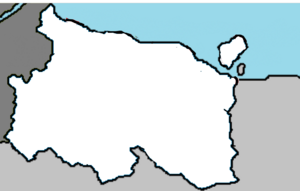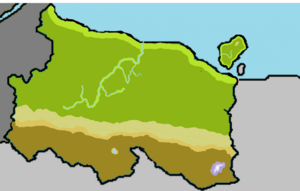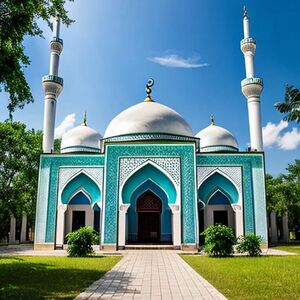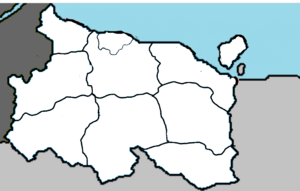Bentho: Difference between revisions
No edit summary |
No edit summary |
||
| Line 73: | Line 73: | ||
|population_density_sq_mi = | |population_density_sq_mi = | ||
|population_density_rank = | |population_density_rank = | ||
|GDP_PPP = | |GDP_PPP = 285.9 Billion | ||
|GDP_PPP_rank = | |GDP_PPP_rank = | ||
|GDP_PPP_year = 2023 May | |GDP_PPP_year = 2023 May | ||
|GDP_PPP_per_capita = | |GDP_PPP_per_capita = 21849.56 | ||
|GDP_PPP_per_capita_rank = | |GDP_PPP_per_capita_rank = | ||
|GDP_nominal = | |GDP_nominal = | ||
Revision as of 04:09, 4 June 2023
Secular Republic of Bentho República Secular de Bentho | |
|---|---|
|
Flag | |
| Motto: "Bentho, Com Todos Os Caminhos e Tempo" | |
Map of Bentho | |
Geogrpahy of Bentho | |
| Capital and City | San Pera |
| Official languages | Benthese, Spanish |
| Ethnic groups | Sarkosian |
| Government | |
• Presdient | Juan Carlos Caballero |
| Population | |
• 2020 estimate | 11,321,987 |
| GDP (PPP) | 2023 May estimate |
• Total | 285.9 Billion |
• Per capita | 21849.56 |
| HDI | .897 very high |
| Date format | MM-DD-YY |
Bentho officially known as the Secular Republic of Bentho, is a sovereign nation located in northeast Ausiana, in the region of Carubana. It is bordered to the west by Vulkaria, to the south by Cirrane, and to the east by Jericho, with a northern coastline along the Sea of Vulkaria in the North Samson Ocean. The 2 Main Reigons of Bentho are the Sarkos tropics and the Cordillera del Illimani. Bentho has 10 States which are Districts of San Pera, Palno, Aregoyape, Barbagaba, Jacardaes, Caumáo, Floriano, Contacicaba, and Huarmos. Bentho has a population of 11.3 million, with the majority of the country's population living near the coast.
Bentho is a member of the Coalition of Crown Albatross.
Etymology
The origin word for Bentho comes from the native Bentheeses word "benção", which translates to "blessing". Native populations which relied heavily on the region's abundant natural resources called the region benção, and later settlements revised to word to "Bentho".
History
Pre-Historic
Bentho was first inhabited around 5,000 years ago by native populations. It is estimated that at the time of the first contact with Adulan explorers in the 19th century there were about 6,000 Native Benthenses and some Huamorian island-settlements.
13th Century
In 1205, the first ever reported source of the term "Bentho" or "Bênção", was used by Sílvio Campos Kanashiro, the the founder of San Pera. The first ever reported use of Bênção which translate to blessing in Bentheese, found in Kanashiro's book entitled Bênçãos da Terra, where he refers to Bênção as Bentho.
20th Century
Bentho gained their independence from --country-- in 1905. The Bentheese economy began to grow with its most important sectors being in lumber, farming, and fishing, and the introduction of the Vulkarian Pass placed Bentho right on the precipice of a new vital and heavily used international shipping lane, which contributed greatly to a boom in its economy. A severe drought in 1929 led to the Bentho Depression, which not only affected the agricultural and freshwater fishing industries, but led to the deaths of tens of thousands of people. A religious reconciliation occured as a result of the depression, which was a major contributing factor in Bentho's relative secularism to this day.
World War
Bentho's government attempted to stay neutral at the outbreak of the World War in 1949, during which time the DSC and Rumaztria had invaded and conquered much of neighboring Vulkaria in order to seize vital port cities and the Vulkarian Pass. Bentho's economy, reliant on international shipping passing through the canal, took a major hit as shipping ceased and neighboring countries joined the League Powers. Bentho's government signed multiple non-hostility treaties with the DSC and Teresta to avoid being drawn into the conflict, but the government was covertly supplying weapons and food to Vulkarian resistance fighters. Bentho successfully remained out of direct conflict for around 8 months, instead becoming a haven for many refugees fleeing fighting in northeastern Ausiana.
Sometime in September 1951, a telegram directed from Bentho to resistance fighters in Vulkaria was intercepted by League Forces in Tilbreg, detailing the covert supply missions. As a result, on October 19th, 1951, Teresta and Gashuera broke their non-aggression treaties with Bentho and invaded through occupied Jericho and Cirrane. Bentho's military, small in comparison to the well-equipped and experienced league forces, was decimated in the invasion, and the country's major population centers were quickly overrun. However, many rebel groups sprung up within Bentho to resist the occupation, with vice-president Francisco Cruz Madruga in particular leading several factions. For two years, brutal urban and rural fighting engulfed Bentho as a sizable portion of the population took up arms against Terestan and Gashueran forces. The Battle of Quipata in early 1953 saw the first instance of Bentho's resistance groups freeing one of their major cities from occupying armies.
By December of 1952, the DSC had been pushed out of the northern half of Vulkaria by Allied forces, and Ruzmatrian forces were in retreat on the southern front. In July 1953, allied forces consisting of Emmirian, Albarinean, and Cadairi troops entered Bentho from the freed areas of Vulkaria and began pushing back Terestan forces. They were joined by the Bentho resistance groups, who were vital in the success of allied forces. Gashuera capitulated on August 6th, 1953, leaving Teresta a weakened and vulnerable military. By August 8th, the capital of San Pera was freed, and on August 19th the last Terestan forces retreated over the border into Jericho. Following the liberation of Bentho, Marcos Amorim Esteves sent two brigades of men to participate in the Eastern Front of the war in Euronia, where they assisted in the liberation of Avergnon.
Geography
Geography in Bentho plays an important role in the development of its culture and history. The two main regions of Bentho are the Sarkos and the Cordillera del Illimani. The Sarkos, located in the northern half of the country, is a warm region which recieves a lot of rain. Major cities are located inside of the tropics, such as Caapulas. Undeveloped areas of the Sarkos are highly protected by government in the form of nature reserves and national parks, which contributes both to the maintaining of Bentho's biodiversity and the tourism sector. The Benthenses Capybara, the national animal, is only found in the Sarkos region.
The Cordillera del Illimani is the southern mountainous region of Bentho. The Cordillera's climate is defined by the Ausianan steppes to the south and the warm tropical ocean temperatures to the north, effectively acting as a rain shadow to much of Cirrane. The region's rainy season occurs from September to March (although it can start as late as December) and a dry, cold season exists from May–August. Mount Alonso is the highest peak in Bentho, with a height of 9,762 feet (2,975 meters).
Demographics
Religion
Religion in Bentho has shifted over time. Prior to the World War, the prominent religion was Sanguine. The decline of religion in Bentho came largely as a result of the Bentho Depression in 1929 and the World War, both events which contributed to a major reevaluation of faiths in Bentheese society. In 2022, 78% of Bentho's population was non-religious.
The most followed religion in Bentho is Catholicism, with around 8% of the population (~905,000 people). Most catholic groups are located in the north of the country. The next largest religion is Shintoism, with 5% of Bentho's population practicing. Islam consists of around 3% of the population and is the fastest growing religion in Bentho. There are laws protecting Islam from hate-crimes, passed by presdient Mónica Ramos in 2003.
Bentho banned religious involvemnt in the government in the Bentho Constitution. As defined in article 7; "Any religion that has a way of overpowering the national or local government must be avoided at all costs, to protect it from biased behavior of his or her ways of life." However, someone who is religious can run for president or political office, though they can face being removed from office if it is deemed religion played a part in their policymaking.
Population
Bentho has a population around 11.3 Million, most of the population is aged 24-29, a quite young population and educated to, 98.4% of people in Bentho know how to read and write. Bentho's population will reach around 15 million in 2050. The majiorty of Bentho's population is native to Bentho, 88% of that are native, 2% are Pongian, 5% are Vulkarian.
A report from San Pera Universty did a test showing that the majority of foreginers visiting or moved here spoke their native lanague and did not get abbused or called insults. The fertility rate in Bentho is 1.54 births per women. There is 993 males per 1,000 females in Bentho.
Politics
Legislature
Bentho has 3 branches of the government in San Pera With the Bentho Senate who has 100 seats, 10 seats per state, the Bentho National Assembly Which has 500 Seats. The senate votes on bills, laws, and political people in Bentho to be put into power in our impeached and has an election every 1.5 years. The National Assembly is more internationally which votes on wars, treaties, militarily prescnces and trade deals, theese people are sworn in every 6 years.
The Senate was founded in 1604 when Bentho began to become more recognized by other nations, the senate election is every 1.5 years, 10 senators will repesent their state
Foreign Relations
Bentho has a diplomatic structures with nations on IEarth. Bentho has multiple embassies in San Pera Headed by the Goverment of Bentho. With globalization, its links to Adula have strengthened. Bentho is a strong advocate of constitutional democracy, and individual liberties. Its international relations historically have been guided by the principles of nonintervention, multilateral ism, respect for national sovereignty, and reliance on the rule of law to settle disputes.
Bentho's goverment is reportedly closest to that of Pongi due to it's government similarities, and historical relations.
Embassies in Bentho
States
| Province | Postal abbrev. |
Capital | Population | National Asembly Seats |
|---|---|---|---|---|
| District of San Pera | DSP | San Pera | 1,493,098 | 10 |
| Palno | PAL | Lazana | 2,119,102 | 17 |
| Caumao | CUA | Monsotivo | 903,216 | 16 |
| Chiquique | CHI | Huabo | 1,236,908 | 8 |
| Aregoyape | ARE | Caapulas | 1,391,043 | 11 |
| Jacardaes | JAC | Quipata | 1,376,210 | 11 |
| Florina | FLO | Jerica | 408,554 | 9 |
| Contacicaba | CON | Yebati | 1,376,210 | 6 |
| Barbagaba | BAR | Lamlota | 983,219 | 8 |
| Huamors | HUA | Tepiapó | 1,413,637 | 12 |
|}
Military
The main miltary of Bentho is the Benthenses Armed Forces(BAF) was created in 1859 when a failed goverment coup happend.. Service for both men and women for atleast 1 year, some factors may alter like sports, disability or illness. Each soilder will have their bill paids for their family. On the island of Huarmos they have their own miltary due to it being a island, the Huarmos Island Forces(HIF) are a branch off the Benthenses Armed Forces. Nearly 250,000 of the Benthenses are currently in the miltary and around 1,000,000 reserves
Bentho doesn't have any country to threaten its soverignty, due to its remote location but it's main miltary is to protects itself. The Bentho Navy is a big help with that by patroling Bentho's water claims in the Sea of Vulkaria. Bentho has an aircraft carrier called the NAe San Pera. The airforce in Bentho called the Fuerza Aérea Bentho or the Benthese Airforce is how Bentho protects it skies. In 1977 it was determined that the mission of the Air Force is to conduct strategic and tactical aerospace operations on behalf of the national defense, exercising the sovereignty of the Benthese airspace and defending the independence, integrity, constitution and laws of the country.
Culture
Sports
Sports in Bentho are huge and the biggest ones are soccer, rugby, and baseball. Bentho Primera División Is the biggest soccer leauge in Bentho with Bentho Leauge 2, Bentho Leauge 3 Bentho Leauge 4 being lower leauges. The Bentheese national football team represents Bentho in international tournaments like the World Cup.
Rugby is also pretty big with Benthos own Caapulas Capybaras placing runners-up in the International Rugby League.
Art
Bentho's art indursty is prodemtnly music and paintings in mesuems Benthos most famous painter, Iker Gutierrez was a painter whos ark is based off his surronings, he would go to a random place in Bentho and paint what he sees. His most famous painting the O Meditação or the meditation. The painter is 83 years old and still produces some amazing work which he donates to the mesuem he loved going to as a kid the Arte do Bentho
Cuisine
Benthenses Cuisine depends on what part of the nation you are in, the north of Bentho with cities like San Pera than you can find food with more vegetables and more food that has more flour, wheat in Bentho is rare to find in culinary products, rice, buckwheat and tapioca is the main source of flour in Bentho.
North Bentho Cuisine has more products that are tropical, sense Bentho exports the most mangoes in Iearth, so cooking with mangoes is quite common throughout the north, in the south Benthenses Cuisine is less diverse than the north.














